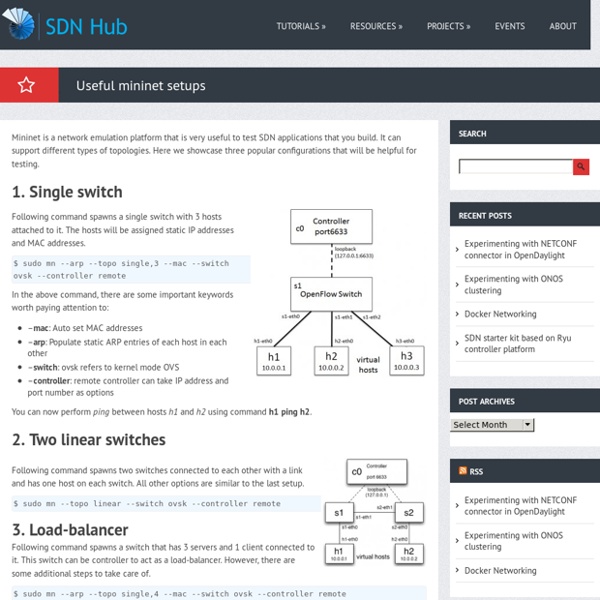Useful mininet setups

SDN Test Suite – Methodology | SDN Hub
SDN Test Suite – Methodology Typical SDN-based Network Virtualization The architecture rolled out can be one of the following: Pure-overlay: Programmable virtual dataplane elements (vDP) are inserted into edge servers and controlled by the controller cluster. Pure-underlay: SDN-enabled top-of-rack or leaf physical switches are deployed and controlled by the controller cluster. Testing these solutions irrespective of the architectural choice makes it essential to adopt a black-box testing methodology that integrates leverages components from the computing world and the networking world. Classes of Tests For testing Network Virtualization, we divided our tests into four main categories: Functionality tests: Essentially these test the claimed (and unclaimed) features of the network-virtualization solution, including the following. Setup for functionality and data plane tests using bare-metal servers Setup for control plane tests Test Suite Design and Architecture Challenges Resources
Software Defined Networking course GA Tech
About the Course This course introduces software defined networking, an emerging paradigm in computer networking that allows a logically centralized software program to control the behavior of an entire network. Separating a network's control logic from the underlying physical routers and switches that forward traffic allows network operators to write high-level control programs that specify the behavior of an entire network, in contrast to conventional networks, whereby network operators must codify functionality in terms of low-level device configuration. Logically centralized network control makes it possible for operators to specify more complex tasks that involve integrating many disjoint network functions (e.g., security, resource control, prioritization) into a single control framework, allowing network operators to create more sophisticated policies, and making network configurations easier to configure, manage, troubleshoot, and debug. Course Syllabus Module 3: Control Plane Prof.
Spanning Tree and OpenFlow
Questions I often get asked include: Can you run Spanning Tree and OpenFlow together?What happens when Spanning Tree blocks a port? Firstly, it is possible to run an OpenFlow network connected to the HP VAN SDN Controller with Spanning Tree turned off. In this blog entry I will show you a simple network with a look and demonstrate what happens with Spanning Tree turned off as well as on using HP Comware switches. VLAN 1 = Management VLAN (Used for communication with the Controller. In this topology I am using two 5900AF-48G-4XG-2QSFP+ switches with the following details: [5900-1]dis version HP Comware Software, Version 7.1.045, Release 2307 Copyright (c) 2010-2013 Hewlett-Packard Development Company, L.P. [5900-2]dis version HP Comware Software, Version 7.1.045, Release 2307 Copyright (c) 2010-2013 Hewlett-Packard Development Company, L.P. In the output below, you can see that Spanning Tree is disabled on VLAN 10: VLAN 192 is the link to the HP VAN SDN Controller: And the result:
Related:
Related:



